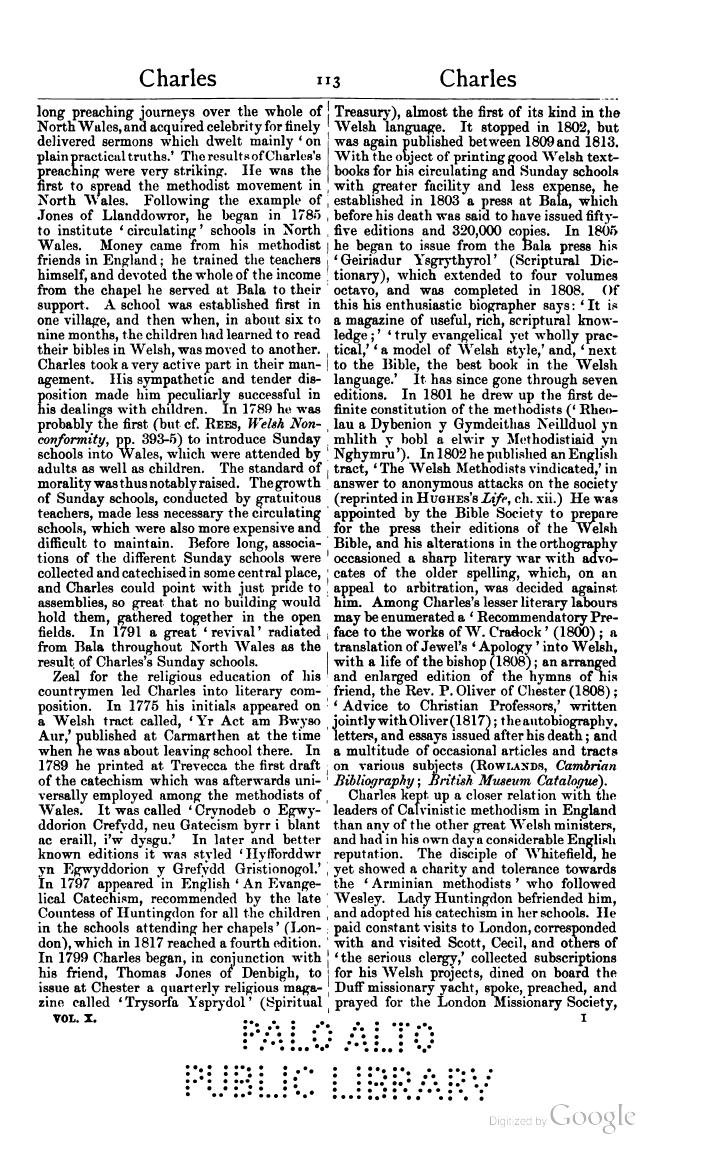long preaching journeys over the whole of North Wales, and acquired celebrity for finely delivered sermons which dwelt mainly ‘on plain practical truths.’ The results of Charles’s reac ing were very striking. He was the grst to s read the methodist movement in North Wyales. Following the example of Jones of Llanddowror, he began in 1785 to institute ‘circulating’ schools in North Wales. Money came from his methodist friends in England; he trained the teachers himself, and cliavoted the whole of the income from the chapel he served at Bala to their support. A school was established first in one village, and then when, in about six to nine months, the children had learned to read their bibles in Welsh, was moved to another. Charles took a very active part in their management. His sympathetic and tender disosition made him peculiarl successful in his dealin with children. In 1789 he was probably the first (but cf. Rees, Welsh Nonconformity, pp. 393-5) to introduce Sunday schools into ilzales, which were attended by adults as well as children. The standard of morality was thus notably raised. The growth of Sunday schools, conducted by gratuitous teachers, made less necessary the circulating schools, which were also more expensive an difficult to maintain. Before long, associations of the different Sunday schools were collected and catechised in some central place, and Charles could point with just pride to assemblies, so great that no building would hold them, thered together in the open fields. In 1791 a great ‘revival’ radiated from Bala throughout North Wales as the result of Charles’s Sunday schools.
Zeal for the religious education of his countrymen led Charles into literary composition. In 1775 his initials appeared on a Welsh tract called, ‘Yr Act am Bwyso Aur,’ published at Carmarthen at the time when be was about leaving school there. In 1789 he printed at Trevecca the first draft of the catechism which was afterwards universally employed among the methodists of Wales. It was called ‘Crynodeb o Egwyddorion Crefydd, neu Gatecism byrr i blant ac eraill, i’w dysgu.’ In later and better known editions it was styled ‘Hyfforddwr yn Egwyddorion y Grefydd Gristionogol.' In 1797, appeared in English ‘An Evangelical Catechism, recommended by the late Countess of Huntingdon for all the children in the schools attending her chapels’ (London), which in 1817 reacied a fourth edition. In 1799 Charles began, in conjunction with his friend, Thomas Jones of Denbigh, to issue at Chester a quarterly religious magazine called ‘Trysorfa Ysprydol ’ (Spiritual Treasury), almost the first of its kind in the Welsh language. It stopped in 1802, but was again published between 1809 and 1813. With the object of printing good Welsh text-books for his circulating an Sunday schools with greater facility and less expense he established in 1803 a press at Bala, which before his death was said to have issued fifty-five editions and 320,000 copies. In 1805 he began to issue from the Bala press his ‘Geiriadur Ysgrythyrol’ (Scriptural Dictionary), which extended to four volumes octavo, and was completed in 1808. Of this his enthusiastic biographer says: ‘It is a magazine of useful, rich, scriptural knowledge;’ ‘truly evangelical yet wholly practical,’ ‘a model of Welsh style,’ and, ‘next to the Bible, the best book in the Welsh language? It has since gone through seven editions. In 1801 he drew up the first definite constitution of the methodists (‘Rheolau a Dybenion y Gymdeithas Neillduol yn mhlith y bobl a elwir y Methodistiaid yn Nghymru’). In 1802 he published an English tract, ‘The Welsh Methodists vindicated in answer to anonymous attacks on the society (reprinted in Hughes's Life, ch. xii.) He was appointed by the Bible Society to prepare for the press their editions of the Welsh Bible, and his alterations in the orthography occasioned a sharp literary war with advocates of the older spelling, which, on an appeal to arbitration, was decided against him. Among Charles’s lesser literary labours may be enumerated a ‘Recommendatory Preface to the works of W. Cradock’ (1800) ; a translation of Jewel’s ‘Apology into Welsh, with a life of the bishop (1808); an arranged and enlarged edition of the hymns of his friend, the Rev. P. Oliver of Chester (1808); ‘Advice to Christian Professors,' written jointly with Oliver(l8l73; the autobiography, letters, and essays issue after his death; and a multitude of occasional articles and tracts on various subjects (Rowlands, Cambrian Bibliographry; British Museum Catalogue).
Charles kept up a closer relation with the leaders of Califinistic methodism in England than any of the other great Welsh ministers, and had in his own day a considerable English reputation. The disciple of Whitefield, he yet showed a charity and tolerance towards the ‘Arminian methodists’ who followed Wesley. Lady Huntingdon befriended him, and adopted his catechism in her schools. He paid constant visits to London, corresponded with and visited Scott, Cecil, and others of ‘the serious clergy,' collected subscriptions for his Welsh projects, dined on board the Duff missionary yacht, spoke, preached, and prayed for the London Missionary Society,
